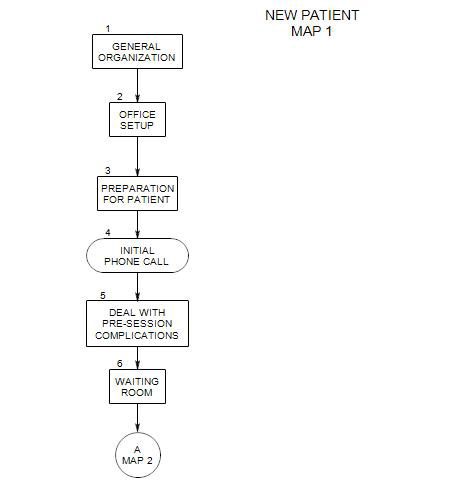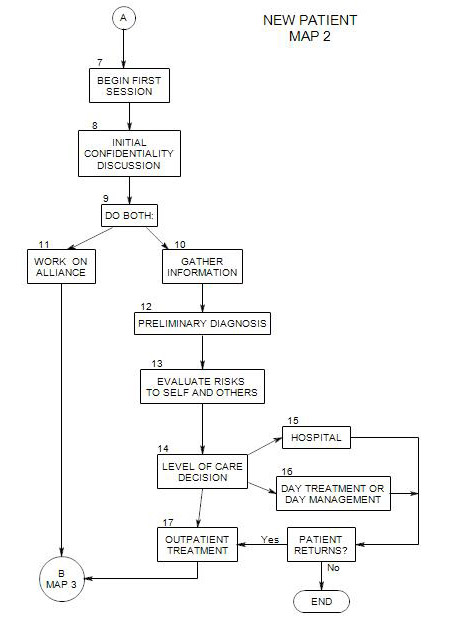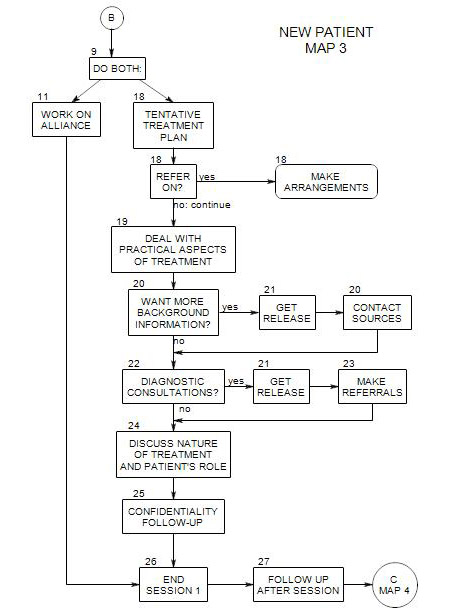6a. General Observations
Here is a first opportunity to observe how the patient presents him/herself, and to begin the diagnostic process
There are many cues, including-
- clothing.
- general attitude and demeanor.
- seating choice.
- how waiting time is spent.
- if anyone came with the patient, then how they sit and relate to each other.
6b. How Do You Greet a Patient?
First impressions matter, to a prospective patient at least as much as to a therapist. How you present yourself should reflect both who you are and the impression you want to make.
Your decision here has a lot to do with-
- how formal or casual you are. A formal start asserts your authority and suggests that you want to get right to work. A more casual approach tells the person to relax, that he/she doesn’t have to be so careful with you.
- whether you want to force the patient to reveal his/her assumptions about what to say and do. How much you control the greeting process or leave it up to the patient.
- how close or distant you want to be.
These issues impact on specific things you may do, such as-
- whether you offer to shake your patient’s hand, or accept his/her offer of a handshake.
- whether you introduce yourself by first name or by last name and title.
- whether you introduce yourself at all.
- how much you say in the waiting room, and how much you reserve for the office.
Traditional psychoanalytic training has often emphasized a minimalist, blank slate approach from the start, where the analyst is encouraged to be formal and withholding. Part of the rationale is that under such conditions you learn more about the prospective patient, who must then project his/her perceptions of other people onto you.
Unfortunately, you may only be learning what he/she projects onto other people who are formal and withholding; and that may not be a very important aspect of his/her reason for seeking your help.
At the same time, such an approach may actually weaken the treatment alliance, which at this point may not be very strong anyway; and it could drive some people away.
Probably the best initial approach is some middle place – formal in some ways, casual in others; sympathetic but not overly so; etc. Then you can adjust a little when you get to know the person better.
To a great extent, your own comfort and the setting determine your answers to these issues. You may need to be formal in a formal setting. You may feel a need to be casual in a small town environment.
6c. Deciding Whom to Interview
If the patient has come with someone else, you need to decide whether to see him/her alone or with the other person.
This can be tricky, because at this point, you typically have very little information about the patient, including diagnostic information or information about the patient’s relationships with others.
Who Should Decide
There are various goals of the first session that may lead to conflict here – even conflict about who should decide.
- On one hand, you should decide because, as the professional, you need to gather information as efficiently as possible and to provide a safe setting for the treatment.
- On the other hand, encouraging the patient to make the choice can be the beginning of a treatment direction that encourages the patient to take charge of his/her life.
- If two or more people have come, it may be of diagnostic value to see who takes charge of this decision, and how.
- and of course, it may not be clear who is or should be the patient.
Reasons for seeing the patient alone:
- Seeing someone else also could dilute your alliance with this patient.
- The other person’s information may be biased and misleading.
- The relationship between the patient and the other person may lead the initial session in directions you are not yet ready to deal with.
- You may not be confident in dealing with more than one person at a time.
Reasons for not seeing the patient alone:
- Your initial alliance may have to be with the other person, especially if the patient is suicidal or unable to talk, or unwilling to talk, or getting secondary gain from his/her symptoms.
- When a patient is brought in by others, it may be because he/she is either unable or unwilling to come alone or may be treatment-resistant. There is likely to be conflict in the family about the patient’s issues. For a variety of reasons, it may be desirable to have the other[s] in for at least part of the session.
- The patient’s judgment may be compromised by his/her disorder or symptoms, or his/her information may be unreliable.
- You can get valuable information from the other person that the patient may not know, remember, or be willing to admit to.
- You can learn something of the patient’s effect on others and/or his/her interactive patterns.
- You may need the other person’s help with some aspects of your preferred treatment for the patient [e.g.: making sure that appointments are kept; arranging transportation, etc].
- You may decide that the couple or the family is the real patient that needs treatment.
- The patient may assume that the other person will be coming in.
- Both may start to come in together.
- The patient may be clearly unable to come in alone.
6d. Making the Decisions
This is a good place to trust your own informed intuitive reactions. Keep your options in mind, and make the best choice you can. Find ways to let the patient and anyone with the patient make their own best choices. Maybe you will learn something valuable at this point, maybe not. If you err, there are many ways to modify choices later on.



